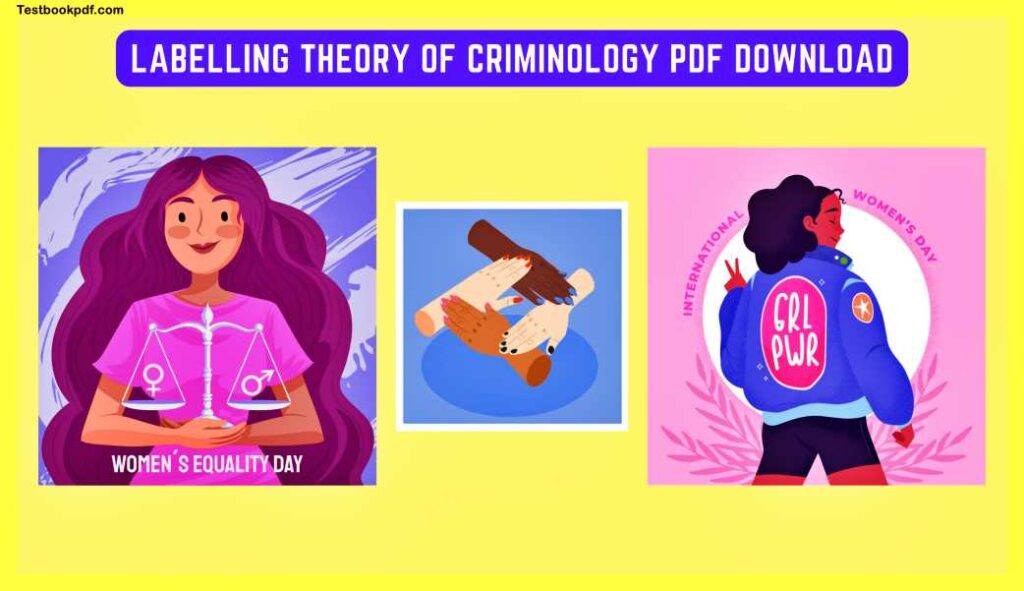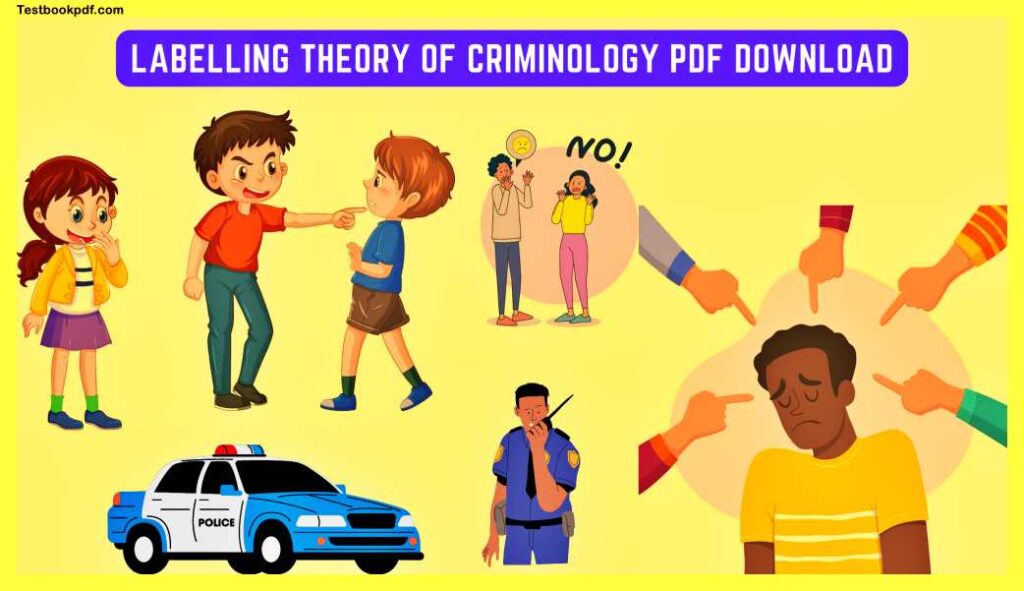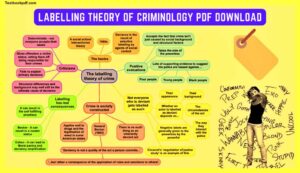Labelling Theory Of Criminology Pdf Download
Today in this article we will talk about the Labelling Theory, Labelling Theory Of Criminology Pdf Download, So let’s know more in Detail with Examples.
What is labeling theory and example?
Labeling theory is a sociological theory that explains how social norms and expectations influence an individual’s behavior. According to labeling theory, people’s behavior is often influenced by the labels that society places on them, and the labels that they adopt for themselves.
For example, if a person is labeled as “criminal,” they may begin to behave in ways that align with that label, even if they did not initially engage in criminal behavior. Similarly, if a person is labeled as “intelligent,” they may be more likely to excel academically and professionally because they believe that they are expected to live up to that label.
Labeling theory has been applied in a variety of contexts, including criminal justice, mental health, and education. It suggests that labels can have a powerful influence on an individual’s self-perception and behavior, and can even shape the way that society views and treats them.
Stigma and Discrimination: The Roots of Labeling Theory
One of the key concepts in labeling theory is stigma, which refers to a negative social identity that is associated with a certain label or category. Stigma can take many forms, including physical, mental, or social characteristics that are perceived as deviant or undesirable by society.
For example, an individual who has a physical disability may be stigmatized by society and treated differently as a result of this label. Similarly, someone who is labeled as “mentally ill” may face discrimination and exclusion from certain social groups or opportunities.
Discrimination is another important concept in labeling theory and refers to the act of treating someone unfairly or differently due to their membership in a particular group. This can take many forms, including unequal access to employment, education, and other social opportunities.
The roots of labeling theory can be traced back to the work of sociologists such as Erving Goffman and Howard Becker, who argued that social labels and categories play a significant role in shaping an individual’s identity and behaviors.
Goffman, in particular, argued that people engage in a process of “impression management” in order to present a particular image or identity to others. He suggested that people are constantly trying to manage the impressions they make on others and to align their behavior with the expectations of their social roles.

Formal and Informal Labeling
Formal labeling refers to the process of assigning a social label or category to an individual by an official or institutionalized body. This can include labels such as “criminal,” “mentally ill,” or “disabled.” Formal labeling often carries significant consequences and may be accompanied by formal sanctions or interventions, such as imprisonment, institutionalization, or treatment programs.
Informal labeling, on the other hand, refers to the process of assigning a social label or category to an individual by informal social groups or networks. This can include labels such as “nerd,” “jock,” or “outcast.” Unlike formal labeling, informal labeling does not have official consequences, but it can still have significant impacts on an individual’s identity and behaviors.
Labeling theory suggests that both formal and informal labeling can have significant impacts on an individual’s identity and behaviors. Formal labeling can shape an individual’s sense of self and influence their interactions with others, while informal labeling can also influence an individual’s identity and behaviors through social norms and expectations.
One of the key arguments of labeling theory is that labeling can create a self-fulfilling prophecy, where an individual begins to act in ways that align with the label they have been given. This can lead to a cycle of stigmatization and discrimination, where individuals who are labeled as “deviant” or “different” may face significant barriers and challenges in their social and professional lives.
Overall, labeling theory emphasizes the importance of social interactions and relationships in shaping an individual’s identity and behaviors and highlights the ways in which formal and informal labeling can have significant impacts on an individual’s life.
Labeling and Deviant Behavior
One of the key concepts in labeling theory is deviant behavior, which refers to actions or behaviors that are perceived as outside the norm or outside of accepted societal standards. Deviant behaviors can vary widely and may include criminal behavior, substance abuse, or other behaviors that are perceived as deviant by society.
Labeling theory suggests that the way society labels individuals who engage in deviant behaviors can have significant impacts on their identity and behaviors. For example, if an individual is labeled as a “criminal,” they may begin to act in ways that align with this label and engage in more criminal behavior. This can lead to a cycle of stigmatization and discrimination, where individuals who are labeled as “deviant” may face significant barriers and challenges in their social and professional lives.
On the other hand, labeling theory also acknowledges that individuals may resist or reject the labels and categories imposed upon them by society. This resistance can take many forms, including individual acts of defiance or collective efforts to challenge the social norms and labels that are imposed upon them.
In the context of criminal behavior, labeling theory suggests that the way society labels individuals who engage in deviant behaviors, such as violence, theft, fraud, drug taking, public nudity, pedophilia, or vandalism, can have significant impacts on their identity and behaviors. For example, if an individual is labeled as a “criminal,” they may begin to act in ways that align with this label and engage in more criminal behavior. This can lead to a cycle of stigmatization and discrimination, where individuals who are labeled as “deviant” may face significant barriers and challenges in their social and professional lives.
Famous labeling theory Story
One famous story that illustrates the concepts of labeling theory is the “Bobo Doll Experiment,” conducted by psychologist Albert Bandura in the 1960s.
In the experiment, children were shown a video of an adult model behaving aggressively towards a toy called a “Bobo doll.” The children were then allowed to play in a room with the Bobo doll and other toys.
The results of the experiment showed that the children who had watched the aggressive model were more likely to behave aggressively towards the Bobo doll, imitating the behavior they had seen in the video.
This experiment illustrates the concept of modeling or social learning, which is the idea that people learn behaviors by observing and imitating others. It also demonstrates the concept of self-fulfilling prophecy, where the children’s expectations of how they should behave were shaped by the label of “aggressive” that had been applied to the model in the video.
Overall, the Bobo Doll Experiment illustrates how labeling and social interactions can shape an individual’s behaviors and identity.

Official Punishment, Peer Rejection, and Labeling in Youths
One of the key arguments of labeling theory is that labeling can create a self-fulfilling prophecy, where an individual begins to act in ways that align with the label they have been given. This can lead to a cycle of stigmatization and discrimination, where individuals who are labeled as “deviant” or “different” may face significant barriers and challenges in their social and professional lives.
In the case of youths, official punishment and peer rejection can both be forms of labeling that can have significant impacts on an individual’s identity and behaviors.
Official punishment refers to the formal sanctions or interventions that are imposed by authorities or institutions, such as imprisonment, institutionalization, or treatment programs. These forms of punishment can be seen as a form of formal labeling and can shape an individual’s sense of self and influence their interactions with others.
Peer rejection, on the other hand, refers to the rejection or exclusion of an individual by their peers or social group. This can be a form of informal labeling and can have significant impacts on an individual’s identity and behaviors through social norms and expectations.
What are the key points of labeling theory?
Labeling theory is a sociological perspective that explains how social labels and categories shape the way individuals see themselves and how they are perceived by others. It is based on the idea that social interactions and relationships play a significant role in shaping an individual’s identity and behaviors.
Some key points of labeling theory include:
- Labeling: Labeling refers to the process of assigning a social label or category to an individual based on their perceived characteristics or behaviors. This can include labels such as “criminal,” “mentally ill,” or “deviant.”
- Self-fulfilling prophecy: Labeling can create a self-fulfilling prophecy, where an individual begins to act in ways that align with the label they have been given. For example, if someone is labeled as a “troublemaker,” they may begin to act in ways that confirm this label.
- Stigma: Labeling can also lead to stigma, which is a negative social identity that is associated with a certain label or category. This can lead to discrimination and exclusion from certain social groups or opportunities.
- Reintegrative shaming: In some cases, labeling can be used as a tool for social control, where individuals are shamed for their deviant behaviors and then encouraged to conform to social norms. This process is known as reintegrative shaming.
- Resistance: Labeling theory also acknowledges that individuals may resist or reject the labels and categories imposed upon them by society. This resistance can take many forms, including individual acts of defiance or collective efforts to challenge the social norms and labels that are imposed upon them.
List of All famous Present Theories of Crime
There are many theories of crime that have been proposed by sociologists, criminologists, and other social scientists. Some of the most well-known theories include:
- Classical criminology: This theory, developed by scholars such as Cesare Beccaria and Jeremy Bentham, emphasizes the role of free will and rational decision-making in criminal behavior. It suggests that people choose to commit crimes based on a calculation of the costs and benefits of their actions.
- Biological theories: These theories suggest that certain physical or genetic characteristics may be related to an individual’s likelihood of engaging in criminal behavior. Examples include the “born criminal” theory, which posits that some people are predisposed to criminal behavior due to inherited physical or psychological traits.
- Psychological theories: These theories focus on the role of individual psychological factors, such as personality traits or cognitive processes, in determining criminal behavior. For example, the social learning theory suggests that people learn criminal behavior through observation and imitation of others.
- Sociological theories: These theories examine the role of social and cultural factors in shaping criminal behavior. Examples include labeling theory, which suggests that the way society labels individuals can influence their likelihood of engaging in criminal behavior, and strain theory, which suggests that crime is more common in societies where there is a gap between the goals people aspire to achieve and the means they have available to achieve them.
- Political and economic theories: These theories focus on the role of political and economic structures in shaping criminal behavior. Examples include conflict theory, which suggests that crime is a result of conflict between different social groups, and Marxist theory, which suggests that crime is a result of class conflict and the inherent contradictions in capitalist societies.
